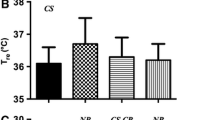Abstract
The influence of body adiposity, arm skinfold thickness, aerobic capacity, and cooling rate were studied in a mock survival swimming situation conducted in water at around 14 °C. Seventeen adult participants wore personal floatation devices on top of seasonal clothing and were asked to swim as far as they could, as if attempting to reach shore following an accidental immersion in cold water. Triceps and patellar skinfold thickness showed a significant correlation with distance covered (r=0.70 and 0.56, respectively), while abdominal skinfold and percent body fat showed no significant correlation. Maximum oxygen consumption (V˙O2max) was not significantly related to distance covered. There was a negative correlation between body cooling rate during the swimming period and distance covered. A multiple stepwise regression analysis, however, indicated that the only significant contributor to variance in the distance covered was the triceps skinfold thickness (r 2=0.49). It was concluded that for a healthy subject accidentally immersed in cold water, triceps skinfold thickness is a stronger predictor of the swimming distance covered than body adiposity, V˙O2max, or the drop in core temperature.
Similar content being viewed by others
Author information
Authors and Affiliations
Additional information
Accepted: 8 December 1999
Rights and permissions
About this article
Cite this article
Wallingford, R., Ducharme, M. & Pommier, E. Factors limiting cold-water swimming distance while wearing personal floatation devices. Eur J Appl Physiol 82, 24–29 (2000). https://doi.org/10.1007/s004210050647
Issue Date:
DOI: https://doi.org/10.1007/s004210050647




